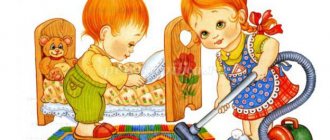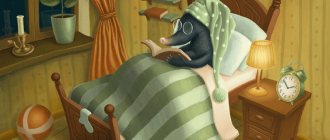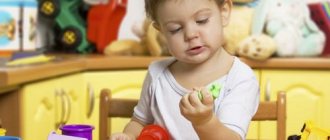How fairy tales can be useful to parents
Fairy tales for children are not only an exciting journey into the world of fictional characters. Through fairy tales, children receive their first knowledge about the structure of life. At first glance, the world of fairy tales may seem black and white, with a clear division into good and evil. However, if we look deeper, fairy tales can also teach children a broader view of events and people. For example, the troubles and trials that befall the hero ultimately help him become stronger and more resourceful and lead to some desired changes. And sometimes in fairy tales there are ambiguous characters who, at first glance, behave like villains, and then are revealed - it is discovered that there are some reasons behind their behavior, or it was not villainous at all, but ultimately helped the hero.
Few parents know that fairy tale therapy can trigger the body’s self-regulation mechanisms. Blogger I am a Parent, clinical psychologist and certified fairytale therapist Ekaterina Blukhterova brings to your attention the therapeutic fairy tale “The Good Forest”: it will help your child find the inner strength for a speedy recovery.
On the role of fairy tales in raising children
The educational function of fairy tales in the education of preschool children
On the role of fairy tales in raising children
Goal: Revealing the historical and psychological aspect of the role of fairy tales in raising children; Objectives: 1. Give an idea of the role of fairy tales in raising a child; 2. Reveal the importance and necessity of introducing a child to a fairy tale from an early age. 3. Foster a love of reading fairy tales. Author: Olga Mikhailovna Struba, methodologist of the Municipal Educational Institution “Childhood and Youth House in Cheremkhovo”, Irkutsk region. This material is intended for an adult audience: 18+. It will be useful to preschool teachers, primary school teachers, organizing teachers, additional education teachers (most likely young professionals) and parents. A fairy tale is the great spiritual culture of a people, which we collect bit by bit, and through a fairy tale the thousand-year history of the people is revealed to us. (Alexey Nikolaevich Tolstoy)
A fairy tale is always present in our lives: we heard it in childhood, we tell it to our children and grandchildren.
For as long as we can remember, next to us are “Kolobok”, “Turnip”, “The Fox and the Wolf”... Russian folk tales, fairy tales of the peoples of the world, author’s: everyday, magical, about animals. A child of any age will definitely say that fairy tales are Pushkin. There is no doubt that Alexander Sergeevich is first remembered as the author of the most famous and beloved fairy tales: “The Tale of Pop and his worker Balda”, “The Tale of the Golden Cockerel”, “The Tale of the Dead Princess”, “The Tale of the Fisherman and the Fish”, “ The Tale of Tsar Saltan", "Groom". The love of fairy tales was instilled in little Sasha by his nanny, Arina Rodionovna, for whom the poet carried love and affection all his life. His warmest memories were associated with her. Frozen with delight, little Pushkin greedily absorbed every word of the wonderful fairy tales. The nanny brightened up his loneliness in exile in Mikhailovskoye, on long winter evenings, continuing to captivate the poet with fairy tales, sayings, proverbs, and songs. “I listen to the fairy tales of my nanny, the original nanny Tatyana; she is my only friend, and with her I’m the only one who doesn’t get bored...” Pushkin wrote to his brother from Mikhailovsky. Pushkin transferred many images from nanny's fairy tales into his works. He always remembered Arina Rodionovna with great warmth and dedicated poems to her. I myself am not happy with my talkativeness, But I love the memories of my childhood years. Oh! Shall I keep silent about my mother, About the charms of mysterious nights, When in a cap, in an ancient robe, She, evading the spirits with prayer, With zeal will cross me, And in a whisper she will begin to tell me About the dead, about the exploits of Bova... From horror I would not move, it happened, Barely breathing, I snuggle under the blanket. Without feeling either my legs or my head. No one knows exactly when the first fairy tale appeared. She has been living among people for a long time. It is known from history that it was customary for our ancestors not to punish those who obeyed, but to guide them on the right path through a fairy tale, story, or instructive story. Reading a fairy tale is considered the most ancient method of learning and education. By communicating with our children through a fairy tale, we pass on to them knowledge about the spiritual world, about the purpose of man in society, we educate them, develop their inner world, and cure them of fears and worries. A fairy tale gives knowledge about life, the laws of existence, awakens creativity, imagination, fosters love for the Motherland, work, teaches to respect elders, protect the weak, help the sick and infirm. Definitely, a folk tale contributes to the formation of certain moral values and ideals. Girls are aimed at the “fair maiden”, who is definitely a needlewoman, and beautiful in mind and face; for boys - a good fellow (necessarily brave, courageous, strong, honest, kind, hardworking, ready to defend his Motherland at any moment). Such perfection is a distant prospect for a child, to which he will strive, comparing his deeds and actions with it. The highest goal set at a young age will largely determine him as a person. Adults need to know the child’s dream in order to correct and eliminate negative aspects in a timely manner. It is considered good form in parenting to read a bedtime story to a child. With the dim light of a night lamp and the soft sound of a native voice, a magical story will lull the baby to sleep and give him good, healthy dreams. In addition, the feeling that a loved one is present next to him has a positive effect on the formation of the child’s psyche. This helps him calm down and feel safe. The child feels that he is loved and cared for. Obviously, the benefits of bedtime stories are truly undeniable. Scientists have long been talking about the therapeutic role of fairy tales, using them in psychological training, in the form of treating the mental state of a small patient. Unfortunately, modern television is loaded to a large extent with foreign cartoons, often aggressive, with brutal fights, with obscure characters, but children imitate their favorite characters, adopt their ways of behavior and manner of speaking. That is why parents and teachers need to be very strict in choosing fairy tales and watching cartoons. It has been proven both scientifically and in real life that children of all ages love to listen to fairy tales and extraordinary stories, which expand the range of their knowledge and horizons, help them gain the necessary knowledge about a person, about life’s problems, and ways to solve them. They give the idea that in addition to the real world, there is also a magical one, filled with miracles and adventures, that good always triumphs over evil. The usefulness of fairy tales is undeniable. Using their example, you can “correct” “wrong” character traits. So, for greedy and selfish kids, it is useful to read the fairy tales “About the Fisherman and the Fish”, “About Three Greedy Bear Cubs”, “The Tale of the Golden Cockerel”, “Frost”, “Ali Baba and the Forty Thieves”, timid and timid, - “ About the Cowardly Bunny”, “Cowardly Vanya”, “The Adventures of Pinocchio”, “The Snow Queen” are suitable for the naughty and gullible. Each of us had a favorite fairy tale, which we listened to and read an incredible number of times. What is the secret of this literary genre? Why do our children, and we adults too, love fairy tales so much, what is their role, what is the benefit? Let us remember that in the old, ancient times, our ancestors were in no hurry to punish children, but told an instructive story so that the offender could comprehend his behavior, draw conclusions and not repeat mistakes. A fairy tale is a very good method of raising and teaching children. By telling fairy tales, we convey the experience of our ancestors, complementing it with our own, no less rich. Through a fairy tale, a child enriches his inner spiritual world, gets rid of worries and fears, gains knowledge about life and its laws, develops imagination and creativity, learns to empathize and anticipate events. Thanks to a fairy tale, a child can play out negative roles and feelings without being punished. Life stories very well separate the idea of male and female behavior. Every fairy tale has a main character. More often this is an active, brave character who knows how to survive in difficult situations. Even if at first he looked negative, the story ends with his correction, comprehension of the negative sides of his character. Each fairy tale teaches that good triumphs over evil, which is important when developing character. The role of fairy tales in shaping a child’s personality has been proven by centuries of experience. These instructive stories teach kindness, forgiveness, tolerance, understanding of what is good and what is bad. They stimulate concentration, develop positive qualities, encourage thinking, encourage questions and search for answers. It is fairy tales that begin a child’s acquaintance with literature and instill in him a love of reading. A fairy tale is a game necessary for personality development. Raising children through a fairy tale is undeniable, because it carries a huge store of knowledge from previous generations. It is she who has an unobtrusive influence on the formation of the child’s thinking, absorbing information through folk art. Through a fairy tale, it is easier to explain to children the common truths rather than moral teachings. A fairy tale is a powerful teaching tool for children and preschoolers. It is through the example of fairy tale heroes that important life information is best learned. Vivid examples modeling correct behavior are such fairy tales as “Kolobok”, “The Gray Goat”, “Teremok”, “The Wolf and the Seven Little Goats”, “Turnip”. They very clearly show different oppositions: courage and cowardice, wealth and poverty, hard work and laziness, ingenuity and stupidity, the success of collectivism and the difficulty of loneliness. Using the example of fairy-tale characters, children learn to distinguish between good and evil, empathize with positive heroes, and mentally overcome difficulties and obstacles with them. Having believed in the simple truth that good triumphs over evil, the child will learn to overcome life’s adversities more steadfastly. We can safely say that from the first minutes of acquaintance with the fairy tale, the child’s character begins to be tempered. It is a known fact that many in childhood experience a feeling of fear: doctors, darkness, being alone in a room. Again, fairy tales can help in this situation. The child observes a seemingly hopeless situation from the outside, and then finds a way to successfully resolve it. The heroes are happy, healthy, evil is defeated. Knowing about the positive outcome of the case, the baby gradually conquers his fears. Many experienced teachers note that children of the 21st century are characterized by a decrease in mental performance, excessive excitability, irritability, emotional exhaustion, and unstable mood. There is inhibition, or vice versa - irritability, aggressiveness. Children are often left at home alone, experiencing a lack of communication with parents and peers, and confining themselves to the TV or computer. With the help of modern technologies, they are bombarded with a barrage of information, often negative. Children have become less sensitive, responsive, and lack communication skills. Therefore, work aimed at developing the emotional sphere is extremely relevant and important. And the main assistant is a fairy tale. K. D. Ushinsky also called the fairy tales of the Russian people the first brilliant attempts at folk pedagogy. Admiring fairy tales as monuments of folk pedagogy, he wrote that no one is able to compete with the pedagogical genius of the people. Remember the Armenian fairy tale in verse “Greedy Vartan”, for whom the furrier sewed as many as seven hats from sheep’s skin, but none of them can be worn? Moral: greed and envy will not lead to good. And “Porridge from an Axe”? About the resourcefulness and ingenuity of the Russian soldier? These instructive stories are a vivid example of folk pedagogy. Fairy tales are an important educational tool, developed and tested by people over centuries. Teachers know different forms of working with fairy tales: reading, retelling, discussion, theatrical performance of fairy tales, watching fairy tale films, holding an expert competition, exhibition of drawings, etc. Life and folk education practices have convincingly proven the pedagogical value of fairy tales. Children and fairy tales are inseparable, and therefore adults should introduce their children to the great spiritual culture of the people from an early age. Some advice for young parents and novice teachers: read a fairy tale, 1. concentrating the child’s attention on it; 2. with expression, highlighting intonation climactic moments; 3. pronouncing words clearly; 4. only one, for deeper understanding; 5. chosen by the child (even if for the hundredth time!); 6. analyzing; 7. ask to retell; 8. preferably before bedtime. “There are no fairy tales better than those that life itself creates.” (Hans Christian Andersen)
We recommend watching:
Formation of a tolerant attitude towards peers in children of senior preschool age The place of fairy tales in the child education system Raising preschool children with a fairy tale The pedagogical value of a fairy tale
Similar articles:
Environmental education of preschool children
Tips for parents on raising preschoolers
Modern approaches to preschool education
Advice for parents: Don’t make an idol out of your child
Raising hard work in a child
How to come up with new endings to existing fairy tales
Sometimes, in order to help a child find a solution to a problem through a fairy tale, you don’t need to compose a new one. It is enough to come up with a new ending to one of those that already exists. Here it is important to choose a fairy tale whose key problem will coincide with the one that is currently relevant for the child. For example, if a child is worried about a strict teacher who gives a lot of tasks or gives low grades, you can discuss the fairy tale about Cinderella with him.
In fairy tales, magic often comes to the aid of the main character. Cinderella, for example, is protected from her stepmother by her fairy godmother. How could Cinderella cope on her own, without magical help? Was her stepmother so unfair to her, since Cinderella herself ran away without completing the “homework” left to her? Did Cinderella have any options to negotiate with her stepmother?
So, with the help of fairy tale therapy, you can help your child change his attitude towards a situation that he experiences as hopeless or unfair. With your help, he will learn to look at the problem from different angles, look for options and not feel small and helpless.
Anna Kolchugina
Does your child believe in miracles? Find out together! TAKE THE TEST!
How to compose a fairy tale with your child
By writing fairy tales with your child, you can touch his inner world, learn about what worries him, scares him, or, on the contrary, inspires and supports him. The plot of a fairy tale is built according to certain canons: in essence, it is a sequence of events united by a certain plot.
Start by creating a main character. Give him a name and image. You can also involve art therapy here - draw a hero or sculpt him from plasticine. Find out from your child what qualities the hero has, what his character is. Discuss what your story will be about. Typically, the main character has a goal and there are obstacles to achieving it. Also in the fairy tale there are hero-allies and hero-opponents. In the process of creating a plot, try to draw parallels with the child’s real life: ask how this relates to his experience and experiences, why did he choose such a goal and such tests for the hero?
How to read a fairy tale with a child
The main goal of discussing fairy tales is to build a connection between the behavior of the characters, the events occurring in the fairy tale and the real-life situations that the child faces. In this case, the plot of the fairy tale is transformed for the child into a personal store of knowledge and ideas, which he can turn to if necessary, for example, if he finds himself in some difficult situation. The famous fairytale therapist Tatyana Zinkevich-Evstigneeva suggests using the following scheme for discussing fairy tales:
A fairy tale is a lie, but there is a hint in it...
Discuss with your child what the fairy tale is about and what it teaches. Ask, in what situations in real life can what a child learned from a fairy tale be useful?
Baba Yaga vs. beautiful girl
Discuss the heroes of the fairy tale. Why does the hero perform this or that action? Why does he need this? What did he really want?
Fire, water and copper pipes
Talk about how the heroes of the fairy tale overcame difficulties. Did they turn to anyone for help? Perhaps someday your child will be able to use these methods in real life.
...a lesson to good fellows!
What feelings does this fairy tale evoke? Which episodes were particularly memorable? What episodes evoked joyful feelings? Which ones are sad? What situations caused fear?
Using the same scheme, you can discuss with your child the feature and animated films you watched together.






